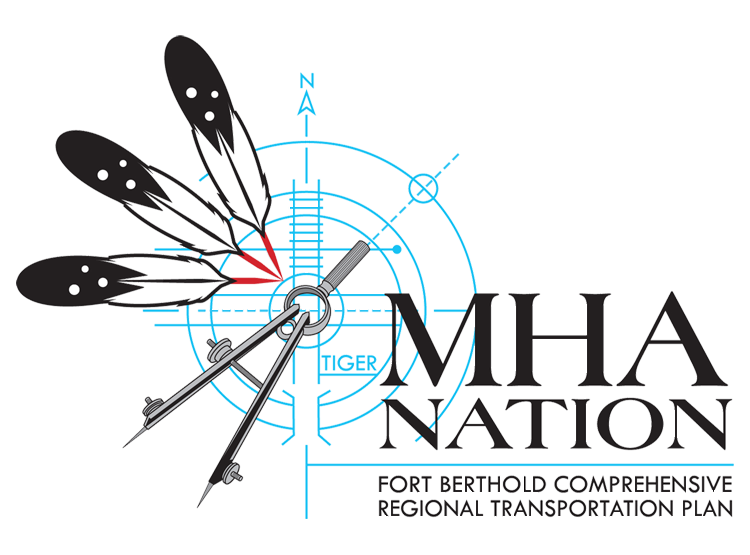STRATEGIC HIGHWAY SAFETY PLAN
Oil development on Fort Berthold has increased truck traffic by nearly 600%1. Not only does truck traffic increase congestion on reservation roads, trucks carrying heavy loads on deteriorating roads poses a significant risk to resident safety.

Strategic Highway Safety Plan (SHSP)
What is a Strategic Highway Safety Plan?
A Strategic Highway Safety Plan (SHSP) is a strategic plan that uses transportation safety data, community input, and guidance from key transportation stakeholders (Tribal, County, State and Federal) in order to identify and address transportation safety issues, specifically the unique conditions that contribute to transportation safety problems on Fort Berthold. The purpose of a SHSP is to identify key road safety needs and guide investment decisions to achieve significant reductions in fatalities and injuries on Fort Berthold roads. It does this by utilizing the 4 E’s-Engineering, Enforcement, Education, and Emergency Service Strategies (see below). It is vital that this is a collaborative effort between Tribal, State, County, and Federal agencies and stakeholders in order to align and leverage resources to address the safety challenges unique to our roads. Being able to understand more detailed data (including the number of individuals in each crash) helps us identify seat belt usage, passenger safety, alcohol/drug impairment and other contributing factors that will be used to develop the Strategic Highway Safety Plan as well as the Long Range Transportation Plan. The plan also describes the jurisdiction, authority, and funding to address identified safety issues.
Engineering– The physical improvements made to a transportation system that reduce crashes and improve transportation safety. Examples include aggressive road curves, fixed objects near roadways (trees or utility poles) that increase the number of fatal or severe crashes, and intersections that have limited visibility.
Education– Initiatives that reshape community behaviors with law “enforcement” through education in order to improve road safety and reduce crashes (ex. “Click it or Ticket” campaign).
Enforcement– Law enforcement (at the state and tribal level) is absolutely essential for deterring people from conducting dangerous behaviors known to increase crash rates (drinking and driving, not wearing a seatbelt, speeding, etc.). The Transportation Department must rely on Tribal Law Enforcement to enforce, collect and report motor vehicle infractions to improve road safety.
Emergency Services– Essential for administering life saving services to individuals involved in traffic crashes. The “Golden Hour” refers generally to the one hour window that emergency responders need to reach and transfer severe trauma patients to the hospital to improve the chances of survival.
MHA Nation currently has a Safety Plan, but not a Strategic Highway Safety Plan. Crash data from the State and Tribe is being collected and analyzed to determine specific safety issues, trends and problematic areas. We have also gathered more complete crash data from the North Dakota Department of Transportation (NDDOT) that details the individuals involved in each crash. This individual level data is important for creating the safety plan because it gives a more accurate sense of how many people are impacted by car crashes. MHA Nation can compete for Safety Planning funds from the Tribal Transportation Program annually. The Strategic Highway Safety Plan will be coordinated North Dakota Department of Transportation’s Strategic Highway Safety Plan.
Why is Strategic Highway Safety Planning Important?
Reliable Data.
By collecting important crash data (including seatbelt usage, passenger safety, and alcohol and drug impairment) as part of the SHSP, we can better understand the specifics of each crash, why they happened, and how they may be prevented in the future.

Road Safety.
The remote Fort Berthold roads were designed to rural agricultural standards; most are unpaved and the large number of semi-trucks carrying heavy loads not only deteriorates road condition but poses a safety concern for residents. In addition, poor roads and heavy traffic delays the ability for vital emergency first responder services to be effective.
Informed Decisions.
By analyzing important specific crash data, we can make informed and consensus-based decisions about how to better improve transportation and road safety on Fort Berthold.
How many people were involved in motor vehicle crashes on Fort Berthold in 2015?
How many people were involved in traffic crashes (fatal or injured) in North Dakota in 2015?
How many people were killed in a motor vehicle crash on Fort Berthold in 2015?
How many people were killed in a motor vehicle crash in North Dakota in 2015?
%
What percentage of the reported fatal crashes on Fort Berthold in 2015 involved alcohol?
%
What percentage of reported fatal crashes were alcohol related in North Dakota in 2015?
%
What percentage of reported crashes on Fort Berthold in 2015 involved semi-trucks?
How many school buses were involved in crashes in North Dakota in 2015?
Source: All Fort Berthold Data from State, County, City law enforcement. All general ND data from NDDOT.
Road Safety Issue Reporter Interactive Map
This interactive web app allows the general public to identify safety related issues in their community. Individuals can plot a point on the map and choose from a list of reports that they wish to create. Once the report is created, it is visible to anyone who accesses the web app and other individuals can comment on the report or give it a vote (similar to a facebook “like”) to show support. Click on the image or title above, or click here to access the map!
Resources
What would YOU like to see addressed in the Strategic Highway Safety Plan?
Enter your full name, a valid email address, and a detailed message in the forms just below to tell us what YOU would like to see in the Strategic Highway Safety Plan. What else would you like to know about it? We also want your stories and perspectives on the questions framing this project; What is our historical relationship to highway safety on Fort Berthold? Where is it today? Where do we want it to be in 20 years?
Also, be sure to follow our blog, Facebook, Instagram, Twitter, Google+ and Linkedin!











